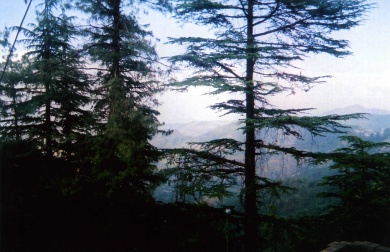Simla, India: Difference between revisions
Jump to navigation
Jump to search
No edit summary |
No edit summary |
||
| Line 3: | Line 3: | ||
[[File:Simla by MG May 2006.jpg|390px|right|thumb|Modern Shimla, May 2006. Photo by Michael Gomes.]] | [[File:Simla by MG May 2006.jpg|390px|right|thumb|Modern Shimla, May 2006. Photo by Michael Gomes.]] | ||
Simla, pronounced and now spelled '''Shimla''', was the summer capital of India during the British Raj. It is located in the state of Himachal Pradesh an elevation of 7,116 feet (2,169 m) in the foothills of the Himalayas. The mountainous terrain providing a climate that was much more tolerable to Europeans than the capital city of Calcutta (now Kolkata) during the summer monsoon. No railway was available until the Kalka-Shimla Railway was completed in 1903.<ref>"Kalka-Simla Railway," [http://en.wikipedia.org/wiki/Kalka-Shimla_Railway Wikipedia].</ref> Early Theosophists in India would have travel by cart to reach the city. | Simla, pronounced and now spelled '''Shimla''', was the summer capital of India during the British Raj. It is located in the state of Himachal Pradesh an elevation of 7,116 feet (2,169 m) in the foothills of the Himalayas. The mountainous terrain providing a climate that was much more tolerable to Europeans than the capital city of Calcutta (now Kolkata) during the summer monsoon. No railway was available until the Kalka-Shimla Railway was completed in 1903.<ref>"Kalka-Simla Railway," [http://en.wikipedia.org/wiki/Kalka-Shimla_Railway Wikipedia].</ref> Early Theosophists in India would have travel by cart to reach the city. | ||
<br> | |||
<br> | <br> | ||
== Notes == | == Notes == | ||
<references/> | <references/> | ||
Revision as of 21:43, 3 September 2013


Simla, pronounced and now spelled Shimla, was the summer capital of India during the British Raj. It is located in the state of Himachal Pradesh an elevation of 7,116 feet (2,169 m) in the foothills of the Himalayas. The mountainous terrain providing a climate that was much more tolerable to Europeans than the capital city of Calcutta (now Kolkata) during the summer monsoon. No railway was available until the Kalka-Shimla Railway was completed in 1903.[1] Early Theosophists in India would have travel by cart to reach the city.